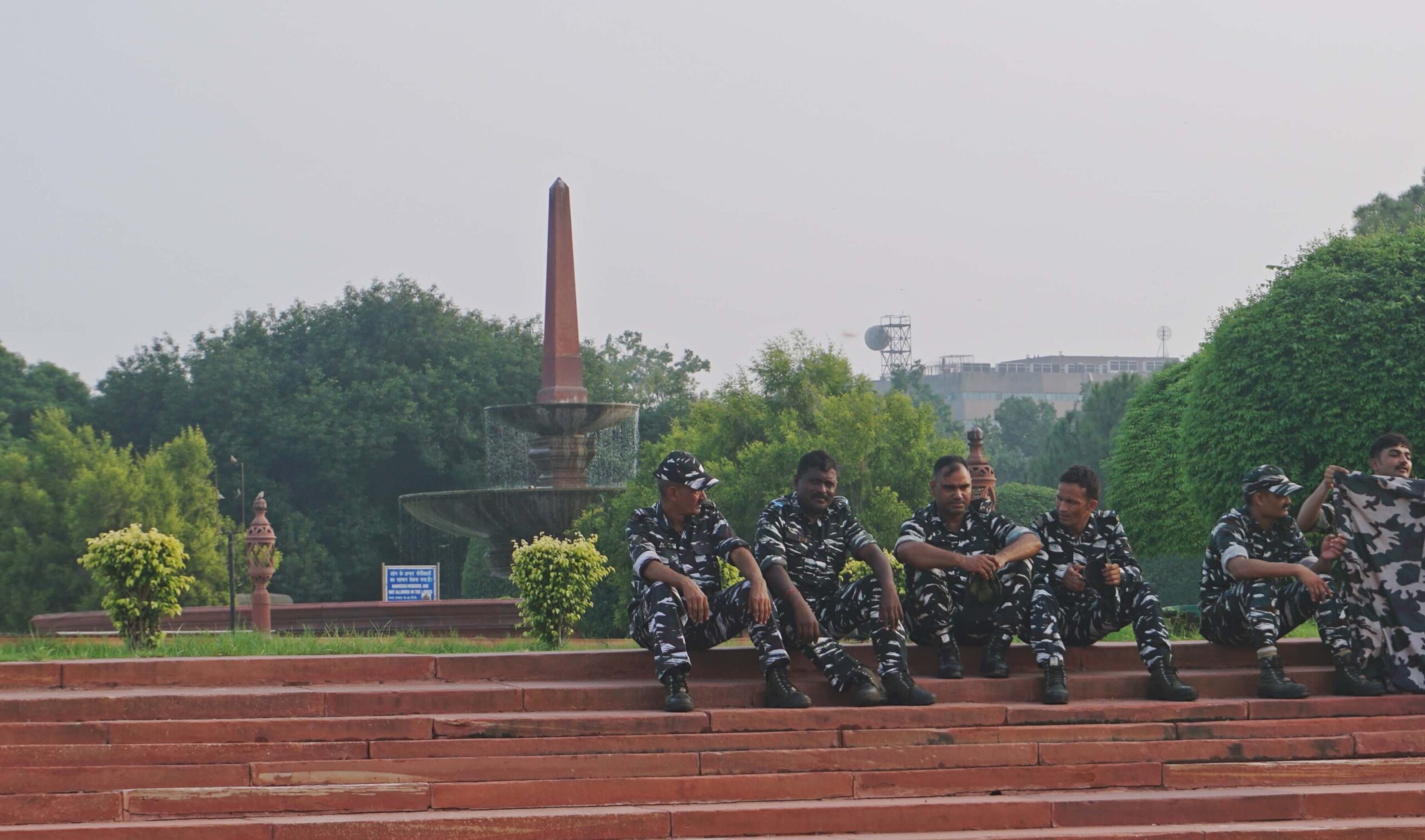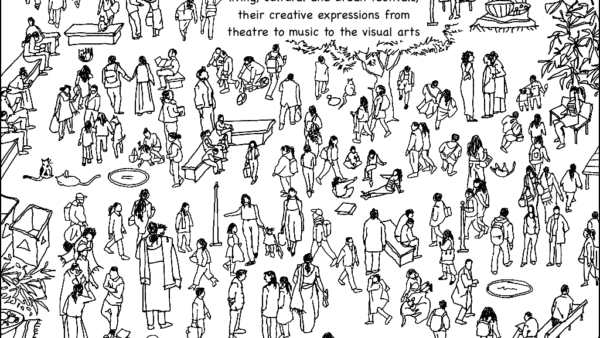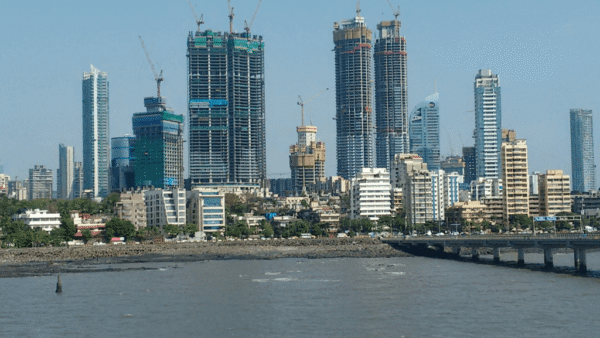It is among the most recognised arterial avenue of a capital city anywhere in the world but it is being transformed to reflect ‘New India’. The three-kilometre-long Rajpath, the distinguishing feature of New Delhi with the central boulevard running along an east-west line straddling the Rashtrapati Bhavan at one end and India Gate at the other, was originally the Kingsway Camp in imperial time and the axis of power in independent India. Through its iterations, as its stately and timeless structures housed the country’s most significant persons and ideas in power, the avenue itself was claimed and championed by people, India’s masses.
The Rajpath had acquired a public character, it was the people’s space to gather and celebrate, to get a breath of fresh air or to assemble in protest, to show up for India’s democracy as it were. The lush green expanses on either side of the avenue, the canals and water bodies, parks and open spaces where people gathered in leisure or with political purpose – all lent the Rajpath a collective commonplace character. Sir Edward Lutyens and Herbert Baker, who designed the avenue and many structures along it including the Parliament building, may not have intended for common Indians to embrace the architectural form as their own space, but people did.
As the Central Vista redevelopment project launched in 2019 to revamp the Rajpath moves at a furious pace, as parts of the avenue remain barricaded to the public and historical structures are razed in the face of resistance by civil society, one of the questions around it is whether the new shiny avenue when completed will continue to offer vast expanses of public space for people to use as they wish or will it constrict the space.
The jury may be out on this but given the opacity around the Central Vista redevelopment project right from its conception to execution so far, there are no assurances from any quarter that the famed Rajpath will continue to offer public space, be the people’s way. The announcement of the project was itself low-key, the entire process from rolling out the notices to selecting HCP Design Planning Ltd, the architecture and design firm led by Bimal Patel – widely seen as translating Prime Minister Narendra Modi’s ‘New India’ vision into the built form – took barely six weeks; it was remarkable also for the complete absence of people’s participation at any stage in the redevelopment of India’s seat of democracy.

Photo: Priyali Dhingra
Land use change
The Central Vista redevelopment project, initially budgeted at a staggering Rs 13,450 crore but estimated to be around Rs 20,000 crore by its scheduled completion in 2026, will give India a new Parliament building – whose triangular design has come in for criticism already – a common central secretariat, new residences for the prime minister and the vice-president, and revamped buildings along the avenue. This revamping will put, according to the plans available, ten office blocks each of 490 x 443 x 130 feet with a large central courtyard, along the Rajpath to house offices of 51 ministries of the Government of India with around 70,000 officials working in them. Going by the plans, the redevelopment will take over a staggering 100-120 acres at Rajpath.[1]
While the country was still waking up to the Covid-19 pandemic, on March 20, 2020, the Union ministry of housing and urban affairs which oversees the redevelopment project, changed the land use for land parcels totalling nearly 86 acres along the avenue. The land use for the 9.5-acre plot for the new Parliament building was changed from recreational to Parliament building, the land use for the 15-acre new residence for the prime minister was changed from recreational to residential, and so on.[2]
As Anuj Srivastava, one of the petitioners against the project in the Supreme Court, told the media then: “The notification for the change of land use is a deeply disturbing development…It is evident that largescale changes are being carried out in haste without any thought for the consequences.” Not only consequences but also without people’s participation or involvement, or even the cursory nod to inviting people’s objections to the grand plans. Under the garb of speed and efficiency, the Central Vista redevelopment project has been marred by secrecy and complete alienation of people.
“…These blocks, ten in all, will march relentlessly down each side of the Rajpath in a manner that encroaches on existing public space and establishes barriers between the Rajpath and the neighbouring areas, like a controlling wall. With their bland exterior façades and their fully glazed atria, these behemoths could have been yanked directly from an office park on a highway somewhere in the U.S. in the 1970s. This is an odd way of signalling a “new Indian Identity” for the 75-year-old democracy. The overall effect of this symmetrical and regimented array of banal boxes is curiously dictatorial,” commented noted architect William JR Curtis.[3]
While the chosen firm has released artists’ impressions and plans of the completed redevelopment project which shows the lawns along the Rajpath in their present state, it is unclear if people’s access to the green spaces and water bodies – even if they are retained – will continue to be what it has been over the last 75 years. Given that the space will be government office space, with its demands of security cordons and traffic movements, common people may not find it as open or free to access the public space along the Rajpath.
Some restrictions on people’s movement along the redeveloped Central Vista are bound to be put in place; some already are. The yellow and red barricades along the avenue send out a strong signal for people to stay back, preventing tourists and strollers from even visually claiming the space; people are seen behind the barricades trying to see the Raisina Hill and take a few memorable photographs. Currently, large sections of the Rajpath are barricaded off as demolition and construction move in tandem but when the redevelopment is done and barricades are removed, there is no certainty that people will have open access to the public space or will be able to use it the way we used to – picnics in the parks, summer swims in the ponds, and equally importantly for protests culminating near the India Gate.
The redevelopment plan, which includes demolition of known landmarks and institutions of repute such as the National Arts Museum and Indira Gandhi National Centre for the Arts, seems like a stealth takeover of public place and heritage zone by the government for itself. A staggering 4,58,820 square metres of the total existing built-up area is slated to be demolished for the revamped Central Vista. It is changing New Delhi’s built environment, reflecting a shrinking of the democratic method both in the built form and the building process. By all reckoning, the government’s expansion of its own footprint is at the cost of depriving citizens of theirs; what was recreational land is no longer so.

Photo: Priyali Dhingra
Ecology and history
Besides the public space aspect, the Central Vista redevelopment project has already resulted in large swathes of trees being chopped off. The Modi government claims that “environmental sustainability” is at the core of the project and that it will not contribute to environmental damage in a city that reels under air pollution and its harmful effects every year. However, nearly 2,000 to 2,400 trees were cut, by an estimate.
“The (Central Vista) projects will result in overall increase in the green cover… Trees will be transplanted in the Eco-Park being developed by NTPC at Badarpur after due permissions from competent authorities,” stated the ministry of housing and urban affairs when work began. Whether this will come to pass is anybody’s guess but even if trees are transplanted, the tree cover at Rajpath – in fact the entire ecosystem that the age-old trees support – would have been lost anyway.
While the redevelopment work continues at a blistering pace, across day and night through the pandemic and after it, there are emissions and noise from work sites, there is waste water discharge and construction waste piles all around increasing the toxicity in the air and ecological stress for people.
Increasingly, this part of Delhi has little in common with the city that journalist-author Khushwant Singh documented in his immemorial books, or the capital of the country which former Prime Minister Jawaharlal Nehru shaped in the immediate post-independence years, or the culturally mysterious capital that historian Rana Safvi discovers every day.
The historic Central Vista was planned by the British government in 1912. Lord Hardinge, the then Viceroy of India, set up a Town Planning Committee which later included the area’s main architect, Sir Edward Lutyens. Built as Kingsway Camp and Queensway Camp, the Rajpath and Janpath have come a long way and are today embodied in the soul of Delhi residents, in fact all Indians who have seen it in photographs and on their screens as the seat of democracy.
The Indira Gandhi National Centre for Arts has been demolished, next in line are Jaipur House, Baroda House, and a long list of historic buildings located in Lutyen’s Delhi to make space for modern buildings of ‘New India’ in which the area was consistently disparaged as being elitist. The carping is ironic considering that the redeveloped Central Vista is likely to become even more exclusive and discriminatory towards common people. “Lutyens’ Delhi is barely two per cent of the city’s area and other parts are nothing like it. However, the figure emphasises its incalculable worth for every citizen, especially those who can never enjoy these boons even a mile away,” writes journalist and researcher Alpana Kishore. [4]
Kishore echoes my experiences as a “Dilliwali” – from having lunch on the Rajpath lawns, taking midnight strolls near the Rashtrapati Bhavan, and gazing at the grand staircase to slurping on ice-cream at the India Gate, daytime and night visuals are embedded memories that meant liberation, a sense of freedom, in every footstep for me. A trip now brings on a sense of confinement and subjugation, as if it was being remade for subjects, not citizens, and I only wonder what access I and millions of us will have to our favourite haunts, to the nooks and corners, once the grand project is all done.
The Rajpath stairs are now occupied by security officials, the lawns lie desolate, the fountains near the Rashtrapati Bhavan once used by young boys from nearby slums have almost dried up. The fountains, hidden behind large trees, were a hangout spots for those seeking refuge from Delhi’s summer heat.

Photo: Wikimedia Commons
Vibrant space for public voices
The Rajpath was also the site of protests, most notably one of India’s biggest movements following the heinous rape of a young physiotherapist in December 2012. The “Nirbhaya” protests saw the pathways of the Central Vista occupied by hundreds of protesters, braving police action, demanding justice for the deceased woman and stricter laws against rape. The three-kilometre-long stretch became the heart of citizens’ voices, a metaphor for India’s soul.
Nine years later, the protests were about the redevelopment of the space. In May 2021, 76 of India’s most respected intellectuals and activists wrote to Prime Minister Modi to express their disapproval and distress at the project. A few days later, 60 former bureaucrats wrote a similar letter and criticised the government expenditure on the project during the vicious second wave of COVID-19. These voices, unlike in the “Nirbhaya” protests, went unheard by the powers that be.
Well-known architect and writer Prem Chandavarkar pointed out the Central Vista’s non-democratic features as its biggest shortfalls. “The spatial centre of our democracy requires a vision of what democracy is, and how the relationship between people and the government serves that vision,” he wrote.[5] Since the area between Vijay Chowk at the Rashtrapati Bhavan and the India Gate will soon have a flurry of government buildings which will take over vibrant public space, it may reflect poorly on India’s vision of democracy, Chandavarkar added.

Photo: Priyali Dhingra
Delhi is a city made rich by its history — hidden Mughal monuments at every nook, grand architecture of the British, and architectural symbols of the Indian struggle for independence. The heart of India’s democratic capital, a heritage site, is once again being transformed to be cast in the image of its powerful men such as Prime Minister Modi who desires a new symbol for ‘New India’ while simultaneously erasing Nehru’s footprints on the built form but, for many, this redevelopment symbolises a ‘conquest’.
“What is the political vision behind this conquest, apart from a simple desire for expansion, power and macho glory? The answer to this question is that this conquest is a re-conquest, a reclamation, a restoration and a reformation, all at once. And Delhi is its most precious prize,” remarked anthropologist Arjun Appadurai. [6]
The government neither opened up the project to people nor did it discuss it in Parliament despite the serious concern of the opposition parties. The project attempts to refurbish public spaces to enhance government functioning – a democratic government functions for the people – but decided to not grant people even a participatory role in its making.
In his book Delhi: A Novel Khushwant Singh wrote, “I asked my soul: What is Delhi? She replied: The world is the body and Delhi its life”. And in the city’s most prized avenue, for years till now, it was the people who breathed life into the space, made it come alive. What claims will people be able to make once the Central Vista is reopened in its grandeur?
Priyali Dhingra is a multimedia journalist based in New Delhi with an interest in visual storytelling. She writes on issues of gender, labour, politics, environment and urban inequality in New Delhi and Hyderabad.
Cover photo: Priyali Dhingra



